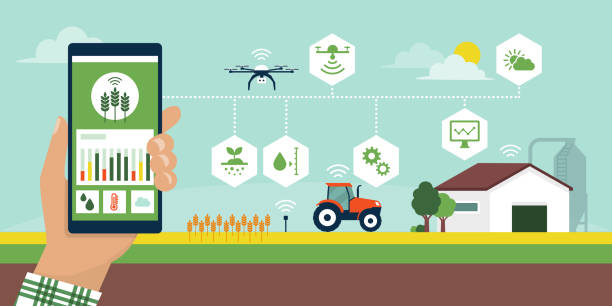
I-FARM U: Connectivity
Data-driven techniques are crucial to increasing farm productivity to meet the food demands of the next 50 years. For example, the advent of aerial imagery systems, such as drones, has enabled farmers to get richer sensor data from the farms allowing them to monitor crop canopy remotely and check for anomalies. Over time, all this data can indicate useful practices in farms and make suggestions based on previous crop cycles, resulting in higher yields, lower inputs, and a reduced environmental impact.Connectivity Solutions provide a way to transport the data gathered on the farm and transfer them to the farmer. Generally, the data is collected from a variety of farm-installed devices, such as cameras, sensors, and drones. The data is sent to a central location, called a network hub, and then transported over the internet for user retrieval. There are a variety of ways to develop connectivity solutions for your farms.
Connectivity solutions provide a way to transport the data gathered on the farm and transfer them to the farmer. Generally, the data is collected from a variety of farm-installed devices, such as cameras, sensors, and drones. The data is sent to a central location, called a network hub, and then transported over the internet for user retrieval. There are a variety of ways to develop connectivity solutions for your farms.
The most common connectivity devices and solutions — and their strengths and limitations

Cellular
Depending on the location of a device and the cellular network’s coverage, a cellular network system enables a device to connect to the internet. Mobile towers are used by cellular networks to offer internet access and communication on mobile devices.
Strengths: Cellular network has a long-range, which implies it covers a large area. Moreover, it has high bandwidth resulting in a strong and stable internet connection. Furthermore, it is mobile; cellular companies can move their cellular towers to different locations.
Weaknesses: In rural locations, several cellular providers don’t provide cellular coverage. Yet, because agricultural activities are typically carried out in rural locations, it is challenging for farmers to use cellular data successfully in their fields. As a result, agricultural robots cannot rely on cellular for internet connectivity.

LoRA
The LoRA (from “long range”) is a physical layer protocol that creates a private network for devices that don’t transfer as much data as computers or cellular phones using the spread spectrum modulation technology.
Strengths: The LoRA may be installed and transported anywhere. Because of this, it is accessible everywhere, even in isolated rural regions such as agricultural fields. Moreover, LoRA has a long-range and broad coverage.
Weaknesses: LoRA has a narrow bandwidth. Thus, it works well for sensing data but not for collecting videos or images.
Resources: https://www.semtech.com/lora/what-is-lora

Satellite
A satellite connectivity has blossomed in recent years to advances in satellites and interest of companies such as Starlink.
Strengths: The satellite has good availability because it is located everywhere around the globe, including remote locations such as farms. Moreover, it has a long range because it is spread out in space.
Weaknesses: Satellites provide bandwidth in the order of 10-100 Mbps, which may not be good enough for some farm applications. They also use bulky antennas that you cannot use on drones/robots easily, preventing mobility.

TV White Space
TV White Space refers to the unused TV channels between the active ones in the very high frequency and ultra-high frequency spectrum. These are typically referred to as the “buffer” channels. In the past, these buffers were placed between active TV channels to protect broadcasting interference. It has since been researched and proven that this unused spectrum can be used to provide broadband Internet access while operating harmoniously with surrounding TV channels.
While a traditional Wi-Fi router has a relatively limited range, around 100 meters under perfect conditions, and can be blocked by walls or other environmental barriers, TV White Space technology can cover an expanse of about 10 kilometers in diameter (100 times the distance)! This breakthrough technology was nicknamed “Super Wi-Fi” because of its superior range and ability to penetrate obstacles such as trees, buildings, and rough terrain.
Strengths: TV White Space has a long range and high bandwidth resulting in strong and stable internet connection everywhere even in remote farming areas.
Weaknesses: TV White Space is not always available. It uses the unused TV channel spectrum. Therefore, when a city has a lot of TV transmission, it is almost impossible to use those free (unused) spectrums. TV White Spaces are only available in places where there are some empty TV channels. They also use bulky devices preventing support for drones/robots.